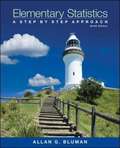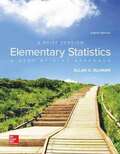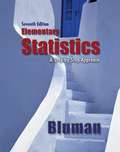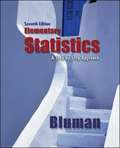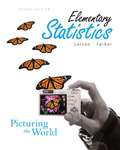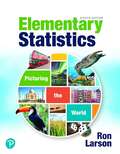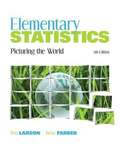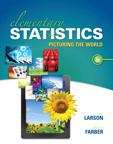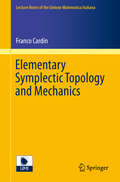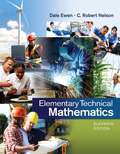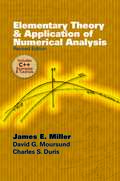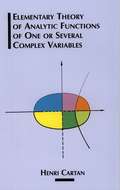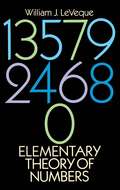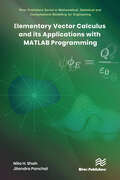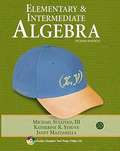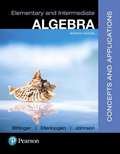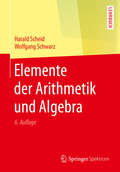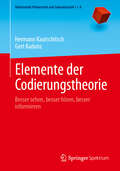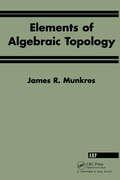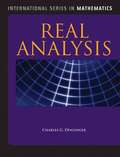- Table View
- List View
Elementary Statistics: A Step By Step Approach (Ninth Edition)
by Allan G. BlumanElementary Statistics: A Step By Step Approach is for introductory statistics courses with a basic algebra prerequisite. The text follows a nontheoretical approach, explaining concepts intuitively and supporting them with abundant examples. In recent editions, Al Bluman has placed more emphasis on conceptual understanding and understanding results. Additionally step-by step instructions on how to utilize the TI-84 Plus graphing calculator, Excel, and Minitab, have also been updated to reflect the most recent editions of each technology.
Elementary Statistics: A Step By Step Approach: A Brief Version
by Allan G. BlumanElementary Statistics: A Brief Version was written as an aid in the beginning Statistics course for students whose mathematical background is limited to basic algebra. The book follows a nontheoretical approach without formal proofs, explaining concepts intuitively and supporting them with abundant examples. The applications span a broad range of topics including problems in business, sports, health architecture, education, entertainment, political science, psychology, history, criminal justice, and many more. While a number of important changes have been made in this next edition, the learning system remains untouched and provides students with a useful framework in which to learn and apply concepts.
Elementary Statistics: A Step by Step Approach
by Allan G. BlumanElementary Statistics: A Brief Version, 4th Edition is a shorter version of Allan Bluman's popular text Elementary Statistics: A Step by Step Approach, 6th edition. This softcover edition includes all the features of the longer book, but is designed for a course in which the time available limits the number of topics covered. The book is written for general beginning statistics courses with a basic algebra prerequisite. The book use a non-theoretical approach, explaining concepts intuitively and teaching problem solving through worked examples step-by-step.
Elementary Statistics: A Step by Step Approach
by Allan G. BlumanELEMENTARY STATISTICS: A STEP BY STEP APPROACH is for general beginning statistics courses with a basic algebra prerequisite. The book is non-theoretical, explaining concepts intuitively and teaching problem solving through worked examples and step-by-step instructions.
Elementary Statistics: A Student Workbook for an Introduction to Statistics
by J EitelThis is the workbook portion of a course in Elementary Statistics. It is accompanied by web based lecture material. Together they from a course in College Statistics.
Elementary Statistics: Picturing The World
by Ron Larson Betsy Farber Elizabeth FarberFor algebra-based Introductory Statistics courses. Offering the most accessible approach to statistics, with a strong visual/graphical emphasis, the text offers a vast number of examples on the premise that students learn best by doing. The fourth edition features many updates and revisions that place increased emphasis on interpretation of results and critical thinking in addition to calculations. This emphasis on statistical literacy is reflective of the GAISE recommendations.
Elementary Statistics: Picturing the World
by Ron LarsonElementary Statistics: Picturing the World describes the world through statistics using stepped-out instruction, extensive real-life examples and exercises, and design that fits content to each page makes the material more digestible. The authors' combination of theory, teaching and learning aids, and design helps you understand concepts and use statistics to describe and think about our world.
Elementary Statistics: Picturing the World (4th Edition)
by Ron Larson Betsy FarberFor algebra-based Introductory Statistics courses. Offering the most accessible approach to statistics, with a strong visual/graphical emphasis, the text offers a vast number of examples on the premise that students learn best by doing. The fourth edition features many updates and revisions that place increased emphasis on interpretation of results and critical thinking in addition to calculations. This emphasis on statistical literacy is reflective of the GAISE recommendations.
Elementary Statistics: Picturing the World (Fifth Edition)
by Ron Larson Betsy FarberThis textbook is written with a balance of rigor and simplicity. It combines step-by-step instruction, real-life examples and exercises, carefully developed features, and technology that makes statistics accessible to all. The Fifth Edition has a thorough update of the key features, examples, and exercises.
Elementary Statistics: Picturing the World, 6th Edition
by Ron Larson Betsy FarberElementary Statistics: Picturing the World, Sixth Edition, provides stepped out instruction, real-life examples and exercises, and the use of technology to offer the most accessible approach. The authors carefully develop theory through strong pedagogy, and examples show how statistics is used to picture and describe the world. In keeping with the premise that students learn best by doing, it includes more than 210 examples and more than 2300 exercises, to make the concepts of statistics a part of students' everyday lives.
Elementary Statistics: Picturing the World, Fourth Edition
by Ron Larson Betsy FarberThe book offers the most accessible approach to statistics, with a strong visual/graphical emphasis and a vast number of examples on the premise that students learn best by "doing". The fourth edition features many updates and revisions that place increased emphasis on interpretation of results and critical thinking in addition to calculations. This emphasis on "statistical literacy" is reflective of the GAISE recommendations.
Elementary Symplectic Topology and Mechanics
by Franco CardinThis is a short tract on the essentials of differential and symplectic geometry together with a basic introduction to several applications of this rich framework: analytical mechanics, the calculus of variations, conjugate points & Morse index, and other physical topics. A central feature is the systematic utilization of Lagrangian submanifolds and their Maslov-Hörmander generating functions. Following this line of thought, first introduced by Wlodemierz Tulczyjew, geometric solutions of Hamilton-Jacobi equations, Hamiltonian vector fields and canonical transformations are described by suitable Lagrangian submanifolds belonging to distinct well-defined symplectic structures. This unified point of view has been particularly fruitful in symplectic topology, which is the modern Hamiltonian environment for the calculus of variations, yielding sharp sufficient existence conditions. This line of investigation was initiated by Claude Viterbo in 1992; here, some primary consequences of this theory are exposed in Chapter 8: aspects of Poincaré's last geometric theorem and the Arnol'd conjecture are introduced. In Chapter 7 elements of the global asymptotic treatment of the highly oscillating integrals for the Schrödinger equation are discussed: as is well known, this eventually leads to the theory of Fourier Integral Operators. This short handbook is directed toward graduate students in Mathematics and Physics and to all those who desire a quick introduction to these beautiful subjects.
Elementary Technical Mathematics
by Dale Ewen C. Robert NelsonELEMENTARY TECHNICAL MATHEMATICS Eleventh Edition is written to help students with minimal math background successfully prepare for technical, trade, allied health, or Tech Prep programs. The authors focus on fundamental concepts in basic arithmetic including the metric system and measurement, algebra, geometry, trigonometry, and statistics, which are supported by thousands of examples, exercises, and applications surrounding such fields as industrial and construction trades, electronics, agriculture/horticulture, allied health, CAD/drafting, HVAC, welding, auto/diesel service, aviation, natural resources, culinary arts, business/personal finance, and others. For this revision, the authors have added over 150 new exercises, 30 new examples, new applications categories, and a new appendix on simple inequalities. The goal of ELEMENTARY TECHNICAL MATHEMATICS is to engage students and provide them with the math background they need to succeed in future courses and careers.
Elementary Theory and Application of Numerical Analysis: Revised Edition (Dover Books On Mathematics Ser.)
by James E. Miller David G. Moursund Charles S. DurisThis updated introduction to modern numerical analysis is a complete revision of a classic text originally written in Fortran but now featuring the programming language C++. It focuses on a relatively small number of basic concepts and techniques. Many exercises appear throughout the text, most with solutions. An extensive tutorial explains how to solve problems with C++.
Elementary Theory of Analytic Functions of One or Several Complex Variables
by Henri CartanNoted mathematician offers basic treatment of theory of analytic functions of a complex variable, touching on analytic functions of several real or complex variables as well as the existence theorem for solutions of differential systems where data is analytic. Also included is a systematic, though elementary, exposition of theory of abstract complex manifolds of one complex dimension. Topics include power series in one variable, holomorphic functions, Cauchy’s integral, more. Exercises. 1973 edition.
Elementary Theory of Numbers (Dover Books on Mathematics)
by William J. LevequeThis superb text introduces number theory to readers with limited formal mathematical training. Intended for use in freshman- and sophomore-level courses in arts and science curricula, in teacher-training programs, and in enrichment programs for high-school students, it is filled with simple problems to stimulate readers' interest, challenge their abilities and increase mathematical strength.Contents:I. IntroductionII. The Euclidean Algorithm and Its ConsequencesIII. CongruencesIV. The Powers of an Integer Modulo mV. Continued FractionsVI. The Gaussian IntegersVII. Diophantine EquationsRequiring only a sound background in high-school mathematics, this work offers the student an excellent introduction to a branch of mathematics that has been a strong influence in the development of higher pure mathematics, both in stimulating the creation of powerful general methods in the course of solving special problems (such as Fermat conjecture and the prime number theorem) and as a source of ideas and inspiration comparable to geometry and the mathematics of physical phenomena.
Elementary Vector Calculus and Its Applications with MATLAB Programming (River Publishers Series in Mathematical, Statistical and Computational Modelling for Engineering)
by Nita H. Shah Jitendra PanchalSir Isaac Newton, one of the greatest scientists and mathematicians of all time, introduced the notion of a vector to define the existence of gravitational forces, the motion of the planets around the sun, and the motion of the moon around the earth. Vector calculus is a fundamental scientific tool that allows us to investigate the origins and evolution of space and time, as well as the origins of gravity, electromagnetism, and nuclear forces. Vector calculus is an essential language of mathematical physics, and plays a vital role in differential geometry and studies related to partial differential equations widely used in physics, engineering, fluid flow, electromagnetic fields, and other disciplines. Vector calculus represents physical quantities in two or three-dimensional space, as well as the variations in these quantities. The machinery of differential geometry, of which vector calculus is a subset, is used to understand most of the analytic results in a more general form. Many topics in the physical sciences can be mathematically studied using vector calculus techniques. This book is designed under the assumption that the readers have no prior knowledge of vector calculus. It begins with an introduction to vectors and scalars, and also covers scalar and vector products, vector differentiation and integrals, Gauss's theorem, Stokes's theorem, and Green's theorem. The MATLAB programming is given in the last chapter. This book includes many illustrations, solved examples, practice examples, and multiple-choice questions.
Elementary and Intermediate Algebra (2nd Edition)
by Katherine R. Struve Janet Mazzarella Michael Sullivan IIIThe Sullivan/Struve/Mazzarella Algebra Series was written to motivate students to "do the math" outside of the classroom through a design and organization that models what you do inside the classroom. The left-to-right annotations in the examples provide a teacher's voice through every step of the problem-solving process. The Sullivan exercise sets, which begin with Quick Checks to reinforce each example, present problem types of every possible derivation with a gradual increase in difficulty level. The new "Do the Math" Workbook acts as a companion to the text and to MyMathLab®by providing short warm-up exercises, guided practice examples, and additional "Do the Math" practice exercises for every section of the text. Operations on Real Numbers and Algebraic Expressions; Equations and Inequalities in One Variable; Introduction to Graphing and Equations of Lines; Systems of Linear Equations and Inequalities; Exponents and Polynomials; Factoring Polynomials; Rational Expressions and Equations; Roots and Radicals; Quadratic Equations; Graphs of Quadratic Equations in Two Variables and an Introduction to Functions. For all readers interested in beginning algebra.
Elementary and Intermediate Algebra: Concepts and Applications (Seventh Edition)
by Marvin L. Bittinger David J. Ellenbogen Barbara L. JohnsonThis program prepares students for the transition from skills-oriented elementary algebra courses to more concept-oriented college-level mathematics courses. This requires the development of critical-thinking skills: to reason mathematically, to communicate mathematically, and to identify and solve mathematical problems.
Elementary and Middle School Mathematics: Teaching Developmentally
by John A. Van de Walle Karen S. Karp Jennifer M. Bay Williams"It is fun to figure out the puzzle of how children go about making sense of mathematics and then how to help teachers help kids. " John A. Van de Walle, Late of Virginia Commonwealth University This is the philosophy behindElementary and Middle School Mathematics: Teaching Developmentally. John A. Van de Walle wrote this book to help students understand mathematics and become confident in their ability to teach the subject to children in kindergarten through eighth grade. Although he could not have foreseen the changes in mathematics teaching over the last three decades, he was at the forefront of the movement towards a constructivist view of teaching, or teaching developmentally. Constructivism says that children construct their own knowledge. They are not blank slates waiting to absorb whatever the teacher tells them. Teachers must understand both mathematics itself and how students learn mathematics in order to teach it effectively. Learning through problem solving is another major theme of this book. Students solve problems not just to apply mathematics, but also to learn new mathematics. Effective problems will take into account where students are, the problematic or engaging aspect of the problem must be due to the mathematics that the students are to learn and not be diluted by non-mathematical activities such as cutting or pasting, and the problem must require justifications and explanations for answers and methods. Learning then becomes an outcome of the problem solving process. The book also addresses in more detail than any other book on the market the effect that the trends of standards-based education, increased pressure to test, and increased teacher accountability have had on teaching mathematics. He addresses the 2000 NCTM Standards in depth, in Chapter 1 on Teaching Mathematics in the Era of the NCTM Standards, through the NCTM icon that appears in the margins throughout the text, and in two appendices in the back of the book. Chapter 5 on Building Assessment into Instruction has also been heavily revised to focus on increased testing pressure, creating more explicit links between objectives and assessment, and including assessments for students with special needs. Elementary and Middle School Mathematics: Teaching Developmentallyis a book for doing math today-for both students who want to become teachers, and the students they will eventually teach. New To This Edition: NEW! Revises Chapter 5 on assessment--Discusses increased testing pressure and accountability, adds more information on equitable assessments, creates more explicit links between objectives and assessment, and includes assessments for students with special needs. NEW! Updates theLiterature Connectionsfeature to remove all out of print children's literature and include more non-fiction, poetry, and other types of readings. NEW! Weaves theFocal Pointsthroughout the chapters as well as links them with theBig Ideasfeature-Focal Pointshave also been added to the Appendix. NEW! Includes expanded coverage of working with diverse learners. NEW! Gives greater emphasis on dealing with math anxiety.
Elemente der Arithmetik und Algebra
by Wolfgang Schwarz Harald ScheidDas Buch richtet sich an Studierende der Mathematik in Lehramtsstudiengängen aller Schulstufen und in polyvalent angelegten Bachelor-Studiengängen. Es vermittelt die Grundlagen der Arithmetik, der elementaren Zahlentheorie und der Algebra sowie interessante Vertiefungen dieser Gebiete. Die vorliegende 6. Auflage ist vollständig überarbeitet und in den einführenden Kapiteln zur Arithmetik und zur Algebra um eine Vielzahl von Kommentaren und Erläuterungen zu mathematischen Verfahrensweisen, Beweistechniken und Notationen ergänzt. Dadurch wird den Studienanfängern der Übergang zur Hochschulmathematik weiter erleichtert. Inhaltlich wurde das Thema vollständige Induktion neu aufgenommen, die Thematik der Kettenbruchdarstellungen wurde umfangreich ausgebaut. In ca. 400 Aufgaben kann der dargestellte Stoff eingeübt, vertieft und auch weitergeführt werden. Zu allen Aufgaben sind knappe Lösungswege oder Lösungshinweise angegeben. Stimme zum Buch: ,,Das Buch besticht durch eine Vielzahl an interessanten Übungsaufgaben (mit Lösungshilfen). " Prof. Hans-Georg Weigand, Universität Würzburg
Elemente der Codierungstheorie: Besser sehen, besser hören, besser informieren (Mathematik Primarstufe und Sekundarstufe I + II)
by Gert Kadunz Hermann KautschitschIm täglichen Leben sind wir zunehmend von Codes umgeben, die mathematisch konstruiert werden. Sie sind teils leicht erkennbar (Strichcode, ISBN, IBAN, QR) und teils eher verborgen (GPS, WLAN, CD, DVD). In diesem Buch werden solche Codes vorgestellt. Es wird dargelegt, wie sie aufgebaut sind, wie sie funktionieren und welche Mathematik zu ihrer Entwicklung und Anwendung notwendig ist. Die Lesenden lernen, eigenhändig Codes zu erstellen, Fehler zu erkennen und zu korrigieren:EAN, ISBN und deren Barcodedarstellung sowie die internationale Bankkontonummer IBAN werden erarbeitet.Kleine QR-Codes werden mit den vorgestellten Methoden (Paritätsprüfung, Linearcode, Polynomcode, zyklischer Code und Reed-Solomon Code) anschaulich realisiert.An der Herstellung einer Mini-CD mit einem CIRC-Code über einem kleinen Körper werden wesentliche Konstruktionsprinzipien von neuen Codes aus bestehenden Codes, wie z.B. Kürzen, Erweitern, Spreizen (Interleaving) und gekreuztes Spreizen (Cross-Interleaving) veranschaulicht.Das Verstehen von Mathematik wird durch diese selbstständige Erstellung und Verwendung didaktisch maßgeschneiderter Codes wesentlich gefördert.Ein besonderer Fokus des Buchs liegt auf elementaren Methoden des Rechnens mit ganzen Zahlen und Polynomen. Für diese benötigt man nur den Satz von der Division mit Rest als zentrale Aussage – daher können große Abschnitte bereits mit Lernenden der Sekundarstufe II erarbeitet und die Grundlagen wesentlicher Teile der Codierungstheorie von den Lernenden mathematisch korrekt erfasst werden. Für Ausführungen, zu deren Verständnis Kenntnisse notwendig sind, die über die Mathematik der Sekundarstufe II hinausgehen, liegt ein ausführlicher Anhang vor (Vektorräume, Matrizen, Rechnen in endlichen Körpern).
Elements Of Algebraic Topology
by James R. MunkresElements of Algebraic Topology provides the most concrete approach to the subject. With coverage of homology and cohomology theory, universal coefficient theorems, Kunneth theorem, duality in manifolds, and applications to classical theorems of point-set topology, this book is perfect for comunicating complex topics and the fun nature of algebraic topology for beginners.
Elements Of Real Analysis (G - Reference, Information And Interdisciplinary Subjects)
by Charles G. DenlingerElementary Real Analysis is a core course in nearly all mathematics departments throughout the world. It enables students to develop a deep understanding of the key concepts of calculus from a mature perspective. Elements of Real Analysis is a student-friendly guide to learning all the important ideas of elementary real analysis, based on the author's many years of experience teaching the subject to typical undergraduate mathematics majors. It avoids the compact style of professional mathematics writing, in favor of a style that feels more comfortable to students encountering the subject for the first time. It presents topics in ways that are most easily understood, without sacrificing rigor or coverage. In using this book, students discover that real analysis is completely deducible from the axioms of the real number system. They learn the powerful techniques of limits of sequences as the primary entry to the concepts of analysis, and see the ubiquitous role sequences play in virtually all later topics. They become comfortable with topological ideas, and see how these concepts help unify the subject. Students encounter many interesting examples, including "pathological" ones, that motivate the subject and help fix the concepts. They develop a unified understanding of limits, continuity, differentiability, Riemann integrability, and infinite series of numbers and functions.

